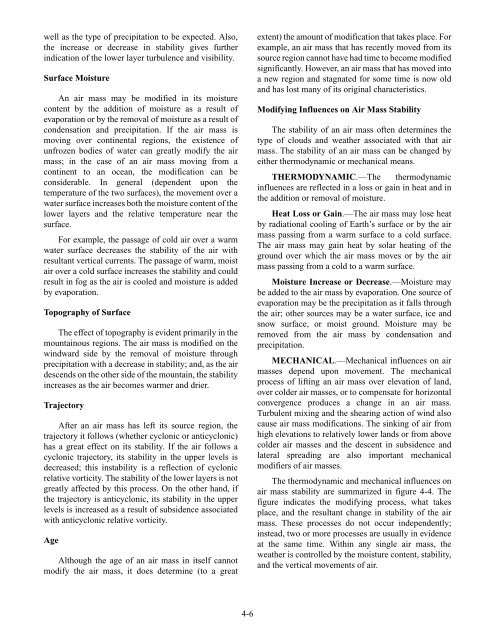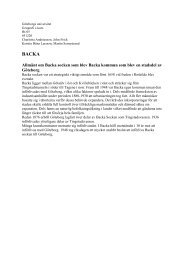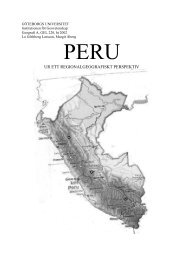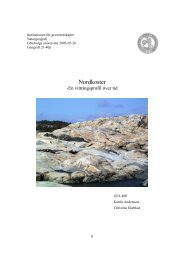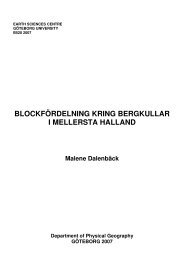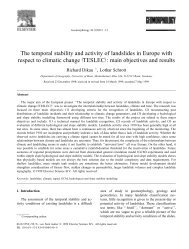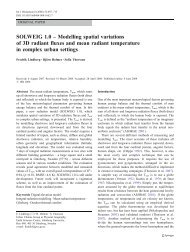AIR MASSES AND FRONTS
AIR MASSES AND FRONTS
AIR MASSES AND FRONTS
You also want an ePaper? Increase the reach of your titles
YUMPU automatically turns print PDFs into web optimized ePapers that Google loves.
well as the type of precipitation to be expected. Also,<br />
the increase or decrease in stability gives further<br />
indication of the lower layer turbulence and visibility.<br />
Surface Moisture<br />
An air mass may be modified in its moisture<br />
content by the addition of moisture as a result of<br />
evaporation or by the removal of moisture as a result of<br />
condensation and precipitation. If the air mass is<br />
moving over continental regions, the existence of<br />
unfrozen bodies of water can greatly modify the air<br />
mass; in the case of an air mass moving from a<br />
continent to an ocean, the modification can be<br />
considerable. In general (dependent upon the<br />
temperature of the two surfaces), the movement over a<br />
water surface increases both the moisture content of the<br />
lower layers and the relative temperature near the<br />
surface.<br />
For example, the passage of cold air over a warm<br />
water surface decreases the stability of the air with<br />
resultant vertical currents. The passage of warm, moist<br />
air over a cold surface increases the stability and could<br />
result in fog as the air is cooled and moisture is added<br />
by evaporation.<br />
Topography of Surface<br />
The effect of topography is evident primarily in the<br />
mountainous regions. The air mass is modified on the<br />
windward side by the removal of moisture through<br />
precipitation with a decrease in stability; and, as the air<br />
descends on the other side of the mountain, the stability<br />
increases as the air becomes warmer and drier.<br />
Trajectory<br />
After an air mass has left its source region, the<br />
trajectory it follows (whether cyclonic or anticyclonic)<br />
has a great effect on its stability. If the air follows a<br />
cyclonic trajectory, its stability in the upper levels is<br />
decreased; this instability is a reflection of cyclonic<br />
relative vorticity. The stability of the lower layers is not<br />
greatly affected by this process. On the other hand, if<br />
the trajectory is anticyclonic, its stability in the upper<br />
levels is increased as a result of subsidence associated<br />
with anticyclonic relative vorticity.<br />
Age<br />
Although the age of an air mass in itself cannot<br />
modify the air mass, it does determine (to a great<br />
4-6<br />
extent) the amount of modification that takes place. For<br />
example, an air mass that has recently moved from its<br />
source region cannot have had time to become modified<br />
significantly. However, an air mass that has moved into<br />
a new region and stagnated for some time is now old<br />
and has lost many of its original characteristics.<br />
Modifying Influences on Air Mass Stability<br />
The stability of an air mass often determines the<br />
type of clouds and weather associated with that air<br />
mass. The stability of an air mass can be changed by<br />
either thermodynamic or mechanical means.<br />
THERMODYNAMIC.—The thermodynamic<br />
influences are reflected in a loss or gain in heat and in<br />
the addition or removal of moisture.<br />
Heat Loss or Gain.—The air mass may lose heat<br />
by radiational cooling of Earth’s surface or by the air<br />
mass passing from a warm surface to a cold surface.<br />
The air mass may gain heat by solar heating of the<br />
ground over which the air mass moves or by the air<br />
mass passing from a cold to a warm surface.<br />
Moisture Increase or Decrease.—Moisture may<br />
be added to the air mass by evaporation. One source of<br />
evaporation may be the precipitation as it falls through<br />
the air; other sources may be a water surface, ice and<br />
snow surface, or moist ground. Moisture may be<br />
removed from the air mass by condensation and<br />
precipitation.<br />
MECHANICAL.—Mechanical influences on air<br />
masses depend upon movement. The mechanical<br />
process of lifting an air mass over elevation of land,<br />
over colder air masses, or to compensate for horizontal<br />
convergence produces a change in an air mass.<br />
Turbulent mixing and the shearing action of wind also<br />
cause air mass modifications. The sinking of air from<br />
high elevations to relatively lower lands or from above<br />
colder air masses and the descent in subsidence and<br />
lateral spreading are also important mechanical<br />
modifiers of air masses.<br />
The thermodynamic and mechanical influences on<br />
air mass stability are summarized in figure 4-4. The<br />
figure indicates the modifying process, what takes<br />
place, and the resultant change in stability of the air<br />
mass. These processes do not occur independently;<br />
instead, two or more processes are usually in evidence<br />
at the same time. Within any single air mass, the<br />
weather is controlled by the moisture content, stability,<br />
and the vertical movements of air.


